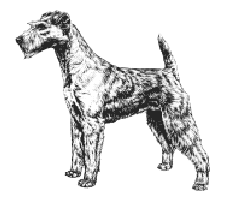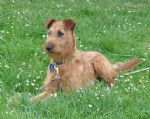Breed Standard - New Zealand
A breed standard is the guideline which describes the ideal characteristics, temperament, and appearance of a breed and ensures that the breed is fit for function with soundness essential. Breeders and judges should at all times be mindful of features which could be detrimental in any way to the health, welfare or soundness of this breed.
Irish Terrier

Group: Terrier
Size: medium
Lifespan: 12-15 years
Exercise: moderate
Grooming: high
Trainability: hard
Watchdog ability: very high
Protection ability: high
Area of Origin: Ireland
Date of Origin: 1700’s
Other Names: Irish Red Terrier
Original Function: hunting fox, otter, and other vermin
History
The Irish Terrier, originally from Country Cork, Ireland, is probably one of the oldest terrier breeds. It is estimated to be two thousand years old, but the earliest images are in a painting from the 1700's. He is a feisty hunter and exterminator of den animals, otter, and water rats. The breed has also been used as a retriever and wartime messenger. The Irish Terrier became very popular in England during the late 1800's. Today the Irish Terrier serves mainly as a companion dog and sturdy, loyal guardian of home and family, though he still retains his vermin hunting prowess. Some of the Irish Terrier’s talents include: hunting, tracking, retrieving, watchdogging, guarding, police work, and military work.
Temperament
Not only do Irish Terriers love to play with children, but he will guard them ruthlessly if required. Irish Terriers are dog-aggressive and will not back down from a fight, and therefore must be trained and kept on a leash when out in public. Irish Terriers are bold and adventurous but also have hot-fiery tempers. It likes to chase and run and hunt and explore; it needs daily physical and mental exercise in a safe area. Given sufficient exercise, it is surprisingly well-mannered and dignified indoors. It is a loyal and entertaining companion.
Upkeep
This is a dog with an active mind and body. It needs daily entertainment and exercise. It makes a good walking and jogging companion, as well as hiking or hunting partner. Its needs can also be met with a rigorous play session. Its wire coat needs combing one or two times weekly, plus scissoring and shaping (clipping for pets and stripping for show dogs) two to four times yearly. Some training of the ears is necessary to ensure proper adult shape.
Official Breed Standard
CHARACTERISTICS:
Dogs that are very game are usually surly or snappish. The Irish Terrier as a breed is an exception, being remarkably good tempered, notably so with humans, it being admitted, however, that he is perhaps a little too ready to resent interference on the part of other dogs. There is a heedless, reckless pluck about the Irish Terrier which is characteristic and coupled with the head- long dash, blind to all consequences, with which he rushes at his adversary, has earned for the breed the proud epithet of "The Dare Devils." When "off duty" they are characterised by a quiet caress-inviting appearance and when one sees them endearingly, timidly pushing their heads into their master's hands, it is difficult to realise that on occasions, at the "set on", they can prove that they have the courage of a lion and will fight unto the last breath in their bodies. They develop an extraordinary devotion for their masters and have been known to track them almost incredible distances.
GENERAL APPEARANCE:
The dog must present an active, lively, lithe and wiry appearance; with lots of substance, at the same time free of clumsiness, as speed and endurance, as well as power, are very essential. They must be neither "cloddy" nor "cobby", but should be framed on the "lines of speeds", showing a graceful "racing outline."
Head and Skull - Head long; skull flat and rather narrow between ears, getting slightly narrower towards the eye; free from wrinkles; stop hardly visible except in profile. The jaw must be strong and muscular, but not too full in the cheek and of a good punishing length. The foreface should not "dish" or fall away quickly between or below the eyes, where it should be well made up, being relieved of "wedginess" by delicate chiselling. The hair should be crisp and only sufficiently long to impart an appearance of additional strength to the foreface. Lips should be well fitting and externally almost black in colour. The nose must be black.
Eyes - A dark colour, small, not prominent and full of life, fire and intelligence. A light or yellow eye is a fault.
Ears - Small and V-shaped, of moderate thickness, set well on the head and dropping forward closely to the cheek. The top of the folded ear should be well above the level of the skull. The ear must be free of fringe and the hair thereon shorter and darker in colour than the body.
Mouth - The teeth should be even, strong and free from discoloration, the top teeth slightly overlapping the lower.
Neck - Should be of a fair length and gradually widening towards the shoulders, well carried and free of toatiness. There is generally a slight frill at each side of the neck running nearly to the corner of the ear.
Forequarters - The shoulders must be fine, long and sloping well into the back. The legs moderately long, well set from the shoulders, perfectly straight, with plenty of bone and muscle; the elbows working freely clear of the sides- pasterns short and straight, hardly noticeable. The forelegs should be moved straight forward when travelling. The hair on the legs should be dense and crisp.
Body - Chest deep and muscular, but neither full nor wide. Body moderately long; back should be strong and straight, with no appearance of slackness behind the shoulders; the loin muscular and slightly arched; ribs fairly sprung, rather deep than round, and well-ribbed back.
Hindquarters - Should be strong and muscular, the thighs powerful, hocks near the ground, stifles moderately bent. The hind legs should be moved straight forward when travelling, the stifles not turned outwards. The hair on the legs should be dense and crisp.
Feet - Should be strong, tolerably round and moderately small; toes arched and neither turned out nor in; black toe nails most desirable. Pads must be sound and free from cracks or horny excrescences.
Tail - Customarily docked to about three quarters; should be free of fringe or feather, but well covered with rough hair, set on pretty high, carried gaily, but not over the back or curled.
Coat - Hard and wiry, having a broken appearance, free of softness or silkiness, not so long as to hide the outline of the body, particularly in the hindquarters, straight and flat, no shagginess and free of lock or curl. At the base of these stiff hairs is a growth of finer and softer hair usually termed the undercoat.
Colour - Should be "whole-coloured", the most preferable colours being a bright red, red wheaten, or yellow red. White sometimes appears on chest and feet and is more objectionable on the latter than on the former, as a speck of white on chest is frequently to be seen in all self-coloured breeds.
Weight and Size -The most desirable weight in show condition is, for a dog 12.2 kg (27 lb), and for a bitch 11.3 kg (25 lb). Height at shoulders approximately 45.7 cm (18 in).
Note: Male animals should have two apparently normal testicles fully descended into the scrotum.
Any departure from the foregoing points should be considered a fault and the seriousness with which the fault should be regarded should be in exact proportion to its degree and its effect upon the health and welfare of the dog.
